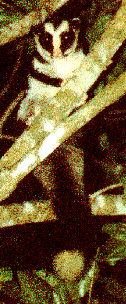|
 |
|
Photo Courtesy
of:
Robin Wingrave
Nocturnal Wildlife Artist |
Striped Possum: Dactylopsila
trivirgata
- Slightly built with a variable pattern of black and white stripes which run along
the length of its body.
- Toes are highly furred and elongated, with the fourth finger particularly
elongated.
- Has a clinging pungent odour
- Has an unusual way of walking, that is, along horizontal branches with a rowing
action (simultaneous swinging movement of diagonally opposite limbs).
- Its position can usually be traced by the noises of its slurping and chewing, or
from the falling of litter from its perch.
Habitat:
- Quite sparse in Australia, more widespread in Papua New Guinea.
- It is a nocturnal animal, thus spending its days sleeping in a leafy nest inside
a tree hollow, or amongst epiphytes which have grown into clumps.
Diet:
- Food finding activities include searching through tree trunks, limbs and fallen
rotting logs to find grubs and other insects. It uses its sharp lower incisors to break
away the bark, or its tongue to extract insects from deep holes and cracks.
- Also feeds on leaves, fruit, small vertebrates and the honey of native bees.
Social Behaviour:
- Even though its a conspicuous animal, the fact that the Striped Possum is a rare
and shy animal makes it one of the least known possums in Australia.
Viewing Opportunities:
- Because of the speed at which it moves, unless it is feeding on insects in a
rotted tree trunk, it is an extremely difficult possum to view.
- Most sightings are made by chance while spotlighting for other possum species.
- Many sightings have been had along the top road at Chambers Wildlife Rainforest
Lodge.
- Other areas include The Crater National Park, the Malanda falls Environmental
Park walking paths,
The Curtain Fig Tree and along the roadway on Thomas Road.
|
